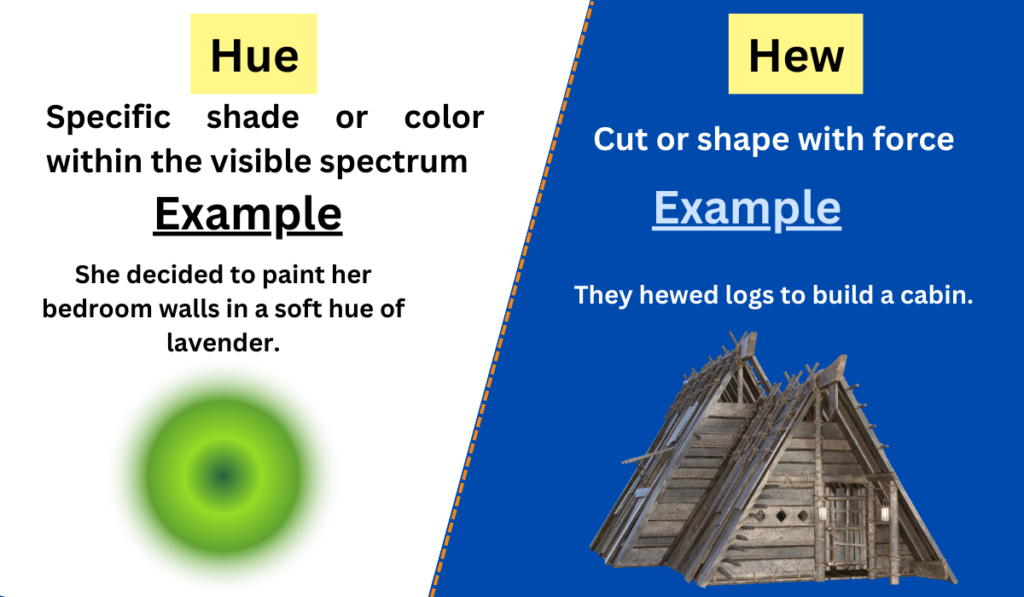Hue vs. Hew-Difference between and example
In the realm of language, certain words may appear similar but possess distinct meanings and applications. “Hue” and “hew” are two such words that often cause confusion.

In this article, we will explore the nuances of “hue” and “hew,” examining their definitions, differences, and appropriate usage.
By understanding the distinctions between these terms, we can communicate more effectively and enrich our language skills.
Join us on this linguistic journey as we unravel the mysteries of “hue” and “hew.”
Meanings and Examples
Hue Definition
Definition: “Hue” refers to a specific shade or color within the visible spectrum.
Examples of Hue
- The painting exhibited a vibrant hue of blue; capturing the essence of the ocean.
- She decided to paint her bedroom walls in a soft hue of lavender.
- The autumn landscape displayed hues of orange, red, and gold.
Hew Definition
The definition of hew is,
Definition: “Hew” means to cut or shape something with force, usually using tools such as a chisel or an axe.
Examples of Hew
- The sculptor hewed a magnificent statue from a solid block of marble.
- The carpenter skillfully hewed the wooden logs to create a sturdy table.
- He hewed the stone into precise shapes to construct the ancient temple.
Difference between Hue and Hew
| Category | Hue | Hew |
| Meaning | Specific shade or color within the visible spectrum | Cut or shape with force, often using tools |
| Example | “The painting exhibited a vibrant hue of blue.” | “The sculptor hewed a magnificent statue from a solid block of marble.” |
| Usage | Describing colors, shades, and pigments | Referring to cutting, shaping, or crafting |
| Context | Art, design, fashion, describing visual aesthetics | Carpentry, sculpture, woodworking, stone masonry |
Usage in a Paragraph
Imagine walking through an art gallery filled with breathtaking paintings. Each canvas showcases a unique hue, immersing you in a world of vibrant colors.
The artists have skillfully employed various pigments to capture the essence of their subjects, from lush green landscapes to radiant sunsets.
In this context, “hue” becomes a key term to describe and appreciate the rich palette of colors on display.
Now, let’s shift to a different setting. Picture a carpenter’s workshop, where the air is filled with the sound of tools and the smell of freshly cut wood.
The carpenter hews the raw timber, using precise strokes to shape it into furniture pieces.
The noise of the saw and the forceful blows of the hammer create an atmosphere of craftsmanship. Here, “hew” is the appropriate word to convey the act of cutting and shaping the wood.
Understanding the difference between “hue” and “hew” enhances our ability to express ourselves accurately.
While “hue” refers to a specific color or shade within the visible spectrum, “hew” denotes the act of cutting or shaping with force, often using tools.
By incorporating these words correctly in our vocabulary, we can better describe colors, appreciate artistic expressions, and convey the artistry of shaping materials.
Let us embrace the beauty of hues and the craftsmanship of hewing as we navigate the colorful world around us.







Leave a Reply